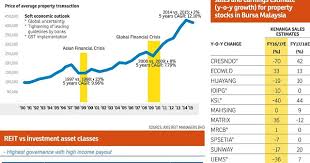Many estate agents and developers generating interests in primary and secondary markets
Popular locations: A section of George Town showing Komtar and the surrounding area. Properties in good locations are said to be still popular.
WHILE the property market in Malaysia may be subdued, Penang is still generating interests among buyers and potential investors.
Raine & Horne Malaysia senior partner Michael Geh says: “Although sentiment is generally cautious, both interest and transactions within the Penang property market is ‘still active’.”
“In the primary market, there are still a lot of estate agents and developers generating interests,” he tells StarBizWeek.
Geh says this is especially the case for affordable homes.
“For middle and upper-end properties, there are still a few projects that are generating interests from genuine buyers,” he says.
“The market is still active. There is activity but transactions have slowed down.”
In terms of the secondary market, Geh says properties in “good locations” are still popular.
“Within the secondary market, there are a lot of enquiries for properties in good locations. In the not-so-good locations, there’s stagnation in both price and activity.”
Geh says demand for landed properties in Penang is still strong.
Bridge boost: Housing project in Bukit Relau. Penang’s second bridge has spurred growth in Batu Maung, Sg Ara, Teluk Kumbar on the island and Batu Kawan on Seberang Prai.
“For the high-rise properties or those that are highly speculated on, there has been stagnation.”
Malaysian Institute of Estate Agents Penang branch state chairman Mark Saw says the property market has been slowing over the past two years due to the cooling measures brought about by the Government.
“Until year-end, things should be slow – assuming that the global economy does not tank. But the market is still active in certain areas.”
He says landed residential properties and the hospitality segment in Penang are “still doing fine”.
“Hotel operators are still looking at Penang as a potential location to set up operations,” Saw says, adding that it is “business as usual” for players within the industrial sector.
“Within the industrial sector, there has been no real slowdown. I mean, we’ve not seen any factory closures.”
For residential properties in Penang, Saw says there had been a “swing towards affordable housing” in the past couple of years.
“In the top end of the market, developers have been more cautious as loans have not been as forthcoming. However, those developers with good stock are still able to continue launching new products.”
Looking ahead, Geh feels the market will “swing” in the final quarter of the year.
“The third quarter tends to be a little bit quiet. It’s in the fourth quarter that I think things will swing, and I believe it can go either way.
“This will depend on various factors, such as sentiment, or if Bank Negara comes out with an announcement that could affect the local property sector. But I think it will swing for the better.”

Saw meanwhile believes that the rental market will remain competitive for the rest of 2016.
“For those speculators and investors who purchased their properties some five years ago, looking to flip (for profit), those properties are coming into the market now and they might have problems selling, especially those having difficulties in servicing their loans.
“So instead, they will try to rent it out. But with a lot of these stocks coming in, it will be more of a tenant’s market than a landlord’s one.”
Penang in 2015
According to the National Property Information Centre, residential property transactions recorded a marked decline in market activity in 2015 by 16.9%.
The state saw a substantial decline in new launches by 47.5% or 2,348 units.
According to Rahim & Co in its Property Market Review 2015/2016, completion of Penang’s second bridge (Sultan Abdul Halim Muad-zam Shah Bridge) in 2013 has spurred growth in Batu Maung, Sg Ara, Teluk Kumbar and Batu Kawan areas.
“A new project to be launched in 2016 is the RM10bil Eco Marina project in Batu Kawan. Eco Marina, by Eco World Development Group Bhd, will include high-rise and landed properties on a 299.64 acres with a golf course adding prestige to the area.
“The development will be gated and guarded. Other projects by the same developer are Eco Terraces in Air Itam, Penang island and Eco Meadows, Bukit Tambun near Juru/Batu Kawan area.”
Other upcoming projects it cited are the Straits Garden Condominium, Platinum III (from RM428,000), D’Zone Condominium and three-storey detached houses in Baymont Residences (RM3.18mil) in Teluk Kumbar.
“There are also The Tamarind@Seri Tanjung Pinang, Raintree Park 2 comprise of two-storey terraced, two-storey semi-detached houses and Avenue Garden, a 17-storey serviced apartment by Tambun Indah and several others.
“An international school has recently been completed at Simpang Ampat within Pearl City development by Tambun Indah Land Bhd.”
According to CH Williams Talhar & Wong (WTW) in its Property Market Report 2016, 287 units of landed properties came into the market in 2015 in Penang Island alone.

<<
Saw: ‘Hotel operators are still looking to set up operations in Penang.
It said prices of newly-launched houses continued to increase, reaching a new benchmark in their respective locations.
WTW added that terraced and semi-detached houses in established neighbourhoods such as Seri Tanjung Pinang in Tanjung Tokong and Island Park & Island Glades in Greenlane, still command strong demand in the secondary market despite the increasing prices.
“Transacted prices of 2½-storey terraced houses and three-storey semi-detached houses in Seri Tanjung Pinang have surpassed RM2mil and RM3mil per unit, respectively.
“However, the hike in prices is expected to taper off in the near future with more new houses entering into the market.”
On the mainland, WTW said demand of landed residential developments remained strong in 2015 underpinned by the improved infrastructure.
“A number of major property players venturing into Seberang Perai for the first time has excited the local market with new housing products. For instance, Ecoworld, positioned as a pioneer in sustainable and green developments launched its maiden residential project known as EcoMeadows in Bukit Tambun.
“With its lush green landscape, gated and guarded concept as well as proximity to the expressway, a typical terraced unit was priced at RM700,000 per unit, a new price benchmark to the market.”
As for high-rise residential properties, WTW said a number of projects were completed in first half of 2015. These included The Address at Bukit Jambul (124 units), Vertiq at Gelugor (318 units), Sierra Residences at Sungai Ara (300 units), Gardens Ville at Sungai Ara (476 units) and The Latitude at Tanjung Bungah (218 units).
Luxurious condos
“A newly completed luxury condominium development located at Batu Ferringhi, known as By The Sea, was developed by Selangor Dredging Bhd.
“It comprises 138 units with floor areas ranging from 1,037 sq ft to 3,012 sq ft.
For new projects launched in 2015, one luxury condominium project that was launched was Shorefront Residence by YTL Land.
“Situated along Lebuh Farquhar which is within the city of George Town, the luxurious condominiums offered 115 units with floor areas ranging from 1,400 sq ft to 3,400 sq ft.”
It said average transacted prices of condominiums in the sub-sale market increased marginally in 2015.
“Moving into 2016, the market is likely to experience slower growth with transaction activities expected to slow down.
“With more affordable flats and apartments being launched and under construction, a spike in the existing supply of high-rise residential units is expected within the next three to five years.”
WTW notes that high-rise residential developments make a strong inroad in Seberang Prai over recent years, with the majority being in the town area especially Butterworth in Seberang Prai Utara.
“Existing condominiums developments that are actively transacted in the secondary market in the past five years included Habour Place and Casia Condominiums.
“Bukit Mertajam is emerging as the next hotspot for high-rise residential developments with a majority of projects in the pipeline and due for completion.”
Condominiums developments remained as the main development trend in Seberang Prai, says WTW, with a number of serviced residences and Soho (small office home office) projects being proposed that are pending approval.
“Prices of a typical condominiums unit have increased around 9% since 2014 to RM370 per sq ft on average.
“The coming few years will see the mushrooming of skycrapers in Butterworth and Bukit Mertajam as several property players plan to develop integrated developments comprising condominiums, serviced residences or Soho together with shopoffices and hotel in these locations given their robust and established business sentiment.” - By Eugene Mahalinggam The Star
It says take-up rates of newly-launched projects are likely to taper off as the rental market in Seberang Prai is less demanding in comparison with the island.
KL firms bullish on Penang sales
Goh: ‘The City Residence and City Mall is expected to contribute RM40mil while The Wave will contribute RM90mil GDV.
Kuala Lumpur-based property development companies in Penang are expecting sales contributions from the state to increase significantly for their upcoming financial year amid a tough property market environment.
Eco World Development Group Bhd, Eastern & Oriental Bhd (E&O), IJM Land Bhd and Mah Sing Group Bhd are some of the Kuala Lumpur-based property companies expecting strong contributions from the state.
Mah Sing, for example, is projecting for Penang to contribute 9% of its revenue for the fiscal year ending Dec 31, 2016 compared to 1% for the previous financial year.
Says group managing director Tan Sri Leong Hoy Kum: “With no project launches in 2015, our properties in Penang contributed 1% or RM26mil to our total sales of RM2.3bil last year, leveraging on the take-up for projects launched before 2015.
“The group has set a target of RM2.3bil for 2016 for all our properties (throughout the country) and Penang is expected to contribute 9% of the revenue for the (current financial) year.
“With the value of the ringgit at an attractive level, we foresee strong buyer interest, particularly from foreigners, who represent 30% of our purchasers in Penang, as well as locals,” says Leong, who is also the CEO of the group.
Ferringhi Residence in Batu Ferringhi and Southbay Plaza in Batu Maung, both on the island, performed well in 2015, says Leong, with take-up rates of 92% and 96%.
Mah Sing plans to launch Ferringhi Residence 2, a high-end condominium project in Batu Ferringhi, in the second half of 2016, while the Southbay Plaza, a mixed-development project, will be completed this year.
 Toh: ‘The group is targeting RM240mil sales this year in Penang.>>
Toh: ‘The group is targeting RM240mil sales this year in Penang.>>
Eco World expects its projects in Penang to generate about RM600mil this financial year ending Oct 31, 2016, compared to RM200mil in the previous year.
Its general manager Khoo Teck Chong says the targeted revenue for the 2016 financial year is RM4bil, compared to RM3bil in 2015.
“The contribution in Penang would come from Eco Terraces in Paya Terubong, which is 40% sold, Eco Bloom, scheduled to be launched in June, and the first phase of Eco Marina, scheduled for launching in October 2016.
“The Eco Terraces and Eco Bloom are priced respectively at over RM850,000 and below RM400,000, which are still considered as affordable by the locals, given the strategic locations of the projects,” he says.
IJM Land is expecting its projects in Penang to generate RM240mil to the revenue for the current financial year ending March 2017, compared to RM168mil in the last financial year.
Its senior general manager Datuk Toh Chin Leong says the projects planned for launch this year are The Trehaus (with a gross development value or GDV of RM64.7mil) in Bukit Jambul, The Senjayu (RM69mil GDV) in Jawi, South Seberang Prai, and The Waterside Residence (RM260mil GDV) for the second phase of The Light Waterfront.
“These projects should help the group realise the targeted RM240mil sales,” Toh says.
E&O also expects the contribution from Penang to improve significantly this year compared to a year ago.
Its marketing and sales general manager (Penang) Christina Lau says that given the strong sales of the last financial year in excess of RM1bil, the group believes that there will be sustained interest in its Penang projects comprising existing launches such as 18 East at Andaman, The Tamarind, and its landed super-luxe terraces Amaris and Andorra, which collectively tally an estimated GDV of RM1bil.
“The sale of these properties coupled with upcoming launches on the remaining plots within Seri Tanjung Pinang Phase 1 (STP1) will keep us busy, as STP1 approaches its maturity, evolving since the maiden launch of the Ariza courtyard terrace homes in 2005. “Now in its eleventh year, STP1 has developed into one of Penang’s most preferred addresses with a vibrant community of more than 20 nationalities,” she adds.
Ivory Properties Group Bhd is carrying out RM1.8bil worth of projects on the island this year.
These are the first phase of Penang WorldCity called Tropicana Bay Residences with a GDV of RM933mil, The Wave with a GDV of RM494mil, and The City Residence and City Mall with a GDV of RM313mil.
Group chief operating officer Goh Chin Heng says The City Residence and City Mall and The Wave will be the main contributors to the group’s current fiscal year revenue ending next March 31.
“The City Residence and City Mall is expected to contribute RM40mil, while The Wave, RM90mil.
“Both projects have done very well and should enable the group to achieve better results for the current fiscal year.
“There are only a handful of units left for both projects,” he adds.
Ideal Property Development Sdn Bhd plans to undertake RM2.723bil worth of condominium projects on the island this year.
Of the amount, the group has already launched the RM378mil Summerskye Residences in Bayan Lepas in January 2016.
The upcoming projects, comprising 3,648 units to be launched between May and November 2016, are strategically located in Bayan Lepas in the south-west district, which is close to the Penang International Airport and the first and second bridges.
The projects are Forest Ville (RM495mil GDV) in May, Bukit Ayun Development (RM1bil GDV) in August, Queens Residences (RM550mil GDV) and Amarene (RM300mil GDV) in August.
Besides the Queens Residences and Bukit Ayun Development projects, which will be priced between RM600,000 and RM900,000, the rest of the schemes are priced between RM450,000 and RM600,000.
“Some of these projects are among those that will be injected into Ideal United Bintang Bhd (IdealUBB) this year,” says Ideal Property executive chairman Datuk Alex Ooi. Ideal Property is the parent company of IdealUBB.
Ooi said that while most developers were holding back launches, the group has decided to go ahead with a variety of property products priced between the RM450,000 and RM900,000 range.
According to Ooi, properties within such a price range are still the most marketable, especially if the location is very strategic. - By David Tan The Star
Related Posts
 Penang is best for property investment in Malaysia
Penang is best for property investment in Malaysia
Feb 29, 2016 ... Penang is best for property investment in Malaysia .... Landed residential
properties much sought after with resilent demand, Market insights.
May 26, 2016
... CBRE|WTW managing director Foo Gee Jen (pic) said that in spite of confidence
issues among
property buyers, there was still good demand...

May 10, 2016 ... Tan pointed out that “property investment is low-risk and is one of the most ....
Landed residential properties much sought after with resilent ...

May 7, 2016
... “
Property price growth for 2015 had dipped 2% compared with 2014, but the .....
Landed residential
properties much sought after wi...

Apr 9, 2016
... A person who already owns a
property can still purchase affordable housing in ....
Landed residential
properties much sought after with resilent ...
 By A;an Tong
By A;an Tong



















